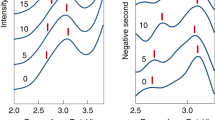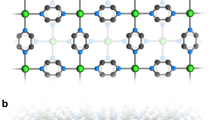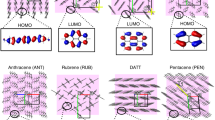Abstract
Metallic conduction generally requires high carrier concentration and wide bandwidth derived from strong orbital interaction between atoms or molecules. These requisites are especially important in organic compounds because a molecule is fundamentally an insulator; only multi-component salts with strong intermolecular interaction—namely, only charge transfer complexes and conducting polymers—have demonstrated intrinsic metallic behaviour. Herein we report a single-component electroactive molecule, zwitterionic tetrathiafulvalene(TTF)-extended dicarboxylate radical (TED), exhibiting metallic conduction even at low temperatures. TED exhibits d.c. conductivities of 530 S cm−1 at 300 K and 1,000 S cm−1 at 50 K with copper-like electronic properties. Spectroscopic and theoretical investigations of the carrier-generation mechanism and the electronic states of this single molecular species reveal a unique electronic structure with a spin-density gradient in the extended TTF moieties that becomes, in itself, a metallic state.
This is a preview of subscription content, access via your institution
Access options
Subscribe to this journal
Receive 12 print issues and online access
$259.00 per year
only $21.58 per issue
Buy this article
- Purchase on Springer Link
- Instant access to full article PDF
Prices may be subject to local taxes which are calculated during checkout




Similar content being viewed by others
Change history
09 August 2017
In the version of this Article originally published, the sign of each x-axis value in Fig. 2d and its inset was incorrect. This has been corrected in the online version. This change does not affect the results of the paper.
01 September 2017
Nature Materials 16, 109–114 (2017); published online 10 October 2016; corrected after print 9 August 2017 In the version of this Article originally published, the sign of each x-axis value in Fig. 2d and its inset was incorrect. This has been corrected in the online version and the correct panel isshown here.
References
Fraxedas, J. Molecular Organic Materials from Molecules to Crystalline Solids (Cambridge Univ. Press, 2006).
Bourbonnais, C. & Jérome, D. in Advances in Synthetic Metals: Twenty Years of Progress in Science and Technology (eds Bernier, P., Lefrant, S. & Bidan, G.) 206–301 (Elsevier, 1999).
Ishiguro, T., Yamaji, K. & Saito, G. Organic Superconductors (Springer, 1998).
Williams, J. M. et al. Organic Superconductors (Including Fullerenes: Synthesis, Structure, Properties, and Theory) (Prentice Hall, 1992).
Powell, B. J. & McKenzie, R. H. Strong electronic correlations in superconducting organic charge transfer salts. J. Phys. Condens. Matter 18, R827–R866 (2006).
Heeger, A. J. Semiconducting and metallic polymers: the fourth generation of polymeric materials (Nobel Lecture). Angew. Chem. Int. Ed. 40, 2591–2611 (2001).
Mulliken, R. S. Molecular compounds and their spectra. II. J. Am. Chem. Soc. 74, 811–824 (1952).
Ferraris, J., Cowan, D. O., Walatka, V. Jr & Perlstein, J. H. Electron transfer in a new highly conducting donor-acceptor complex. J. Am. Chem. Soc. 95, 948–949 (1973).
Tanaka, H., Okano, H., Kobayashi, H., Suzuki, W. & Kobayashi, A. A three-dimensional synthetic metallic crystal composed of single-component molecules. Science 291, 285–287 (2001).
Haddon, R. C. Design of organic metals and superconductors. Nature 256, 394–396 (1975).
Wong, J. W. L. et al. Pressure induced phase transitions and metallization of a neutral radical conductor. J. Am. Chem. Soc. 136, 1070–1081 (2014).
Kobayashi, Y., Yoshioka, M., Saigo, K., Hashizume, D. & Ogura, T. Hydrogen-bonding-assisted self-doping in tetrathiafulvalene (TTF) conductor. J. Am. Chem. Soc. 113, 9995–10002 (2009).
Terauchi, T., Kobayashi, Y., Iwai, H. & Tanaka, A. Protonic defect induced carrier doping in TTFCOO−NH4+: tunable doping level by solvent. Synth. Met. 162, 531–535 (2012).
El-Ghayoury, A. et al. A neutral zwitterionic molecular solid. Chem. Eur. J. 16, 14051–14059 (2010).
Isono, T. et al. Hydrogen bond-promoted metallic state in a purely organic single-component conductor under pressure. Nat. Commun. 4, 1344 (2013).
Terauchi, T. et al. A stable metallic state of (TTPCOO)2NH4 with a mobile dopant. Chem. Commun. 50, 7111–7113 (2014).
Nakamura, T., Furukawa, K., Terauchi, T. & Kobayashi, Y. Microscopic evidence of a metallic state in the one-pot organic conductor ammonium tetrathiapentalene carboxylate. Phys. Status Solidi 9, 480–484 (2015).
Terauchi, T., Kobayashi, Y. & Misaki, Y. Synthesis of bis-fused tetrathiafulvalene with mono- and dicarboxylic acids. Tetrahedron Lett. 53, 3277–3280 (2012).
Mori, T. et al. Metal-insulator transition in the organic metal (TTM-TTP)I3 with a one-dimensional half-filled band. Phys. Rev. Lett. 79, 1702–1705 (1997).
Dugdale, J. S. The Electrical Properties of Metals and Alloys (Edward Arnold Publishers Ltd, 1977).
Kanoda, K. Metal-insulator transition in κ-(ET)2X and (DCNQI)2M: Two contrasting manifestations of electron correlation. J. Phys. Soc. Jpn 75, 051007 (2006).
Giffard, M. et al. The first evidence for the generation of radicals and formation of electrically conducting molecular materials by protic doping of tetrathiafulvalenes. Adv. Mater. 6, 298–300 (1994).
Olaya, A. J. et al. Four-electron oxygen reduction by tetrathiafulvalene. J. Am. Chem. Soc. 133, 12115–12123 (2011).
Gilli, P., Bertolasi, V., Ferretti, V. & Gilli, G. Covalent nature of the strong homonuclear hydrogen bond. study of the O-H—O system by crystal structure correlation methods. J. Am. Chem. Soc. 116, 909–915 (1994).
Anderson, P. W. The Fermi glass: theory and experiment. Comments Solid State Phys. 2, 193–198 (1970).
Kobayashi, A., Fujiwara, E. & Kobayashi, H. Single-component molecular metals with extended-TTF dithiolate ligands. Chem. Rev. 104, 5243–5264 (2004).
Datta, A. & Pati, S. K. Dipolar interactions and hydrogen bonding in supramolecular aggregates: understanding cooperative phenomena for 1st hyperpolarizability. Chem. Soc. Rev. 35, 1305–1323 (2006).
Misaki, Y. Tetrathiapentalene-based organic conductors. Sci. Technol. Adv. Mater. 10, 024301 (2009).
Jursenas, S. et al. Free and self-trapped charge-transfer excitons in crystals of dipolar molecules of N,N-dimethylaminobenzylidene 1,3-indandione. J. Phys. Chem. B 102, 1086–1094 (1998).
Frisch, M. J. et al. Gaussian 09 (Gaussian, 2009).
Becke, A. D. Density functional thermochemistry. III. The role of exact exchange. J. Chem. Phys. 98, 5648–5652 (1993).
Lee, C., Yang, W. & Parr, R. G. Development of the Colle-Salvetti correlation-energy formula into a functional of the electron density. Phys. Rev. B 37, 785–789 (1988).
Dunning, T. H. Jr Gaussian basis sets for use in correlated molecular calculations. J. Chem. Phys. 90, 1007–1023 (1989).
Acknowledgements
We acknowledge C. Kloc (NTU), J. Hui (NTU) and T. Nakamura (IMS) for fruitful discussions. We also thank Y. Ide (NIMS), C. Nishimura (NIMS), M. Sumiya (NIMS), K. Tashiro (NIMS), H. Yoshikawa (NIMS) and M. Ohnuma (Hokkaido University) for discussions and technical support. We acknowledge S. Kurosawa (NIMS) and M. Takahashi (NIMS) for assistance in sample preparation and physical measurements. This study was partially supported by the ‘NEXT’ Program of the Ministry of Education, Culture, Sports, Science and Technology (MEXT), Japan, and Nano-Integration Foundry and the ‘Low-Carbon Research Network’ in NIMS.
Author information
Authors and Affiliations
Contributions
Y.K. and T.T. prepared the materials. Y.K. carried out spectroscopic analyses and MO calculations. Y.K. and S.S. measured transport properties. Y.M. carried out XRD analysis. Y.K. conceived the project and wrote the manuscript.
Corresponding author
Ethics declarations
Competing interests
The authors declare no competing financial interests.
Supplementary information
Supplementary Information
Supplementary Information (PDF 906 kb)
Rights and permissions
About this article
Cite this article
Kobayashi, Y., Terauchi, T., Sumi, S. et al. Carrier generation and electronic properties of a single-component pure organic metal. Nature Mater 16, 109–114 (2017). https://doi.org/10.1038/nmat4768
Received:
Accepted:
Published:
Issue Date:
DOI: https://doi.org/10.1038/nmat4768
This article is cited by
-
Organic radicals in single-molecule junctions
Science China Materials (2024)
-
Recent Advances of Stable Phenoxyl Diradicals
Chemical Research in Chinese Universities (2023)
-
Intrinsic glassy-metallic transport in an amorphous coordination polymer
Nature (2022)
-
Mixed valence salts based on carbon-centered neutral radical crystals
Communications Chemistry (2018)
-
Correction: Corrigendum: Carrier generation and electronic properties of a single-component pure organic metal
Nature Materials (2017)



